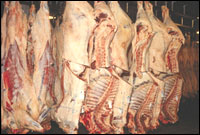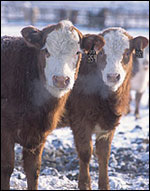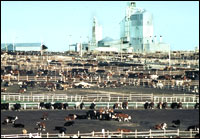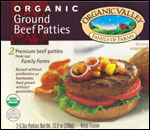In December, the vision of a “downer” cow stricken with bovine spongiform encephalopathy (BSE) caused indigestion in more than a few Americans, especially those who’d eaten beef in one of the six Western states in which the “mad” cow’s meat might have been sold. The potential hazards of this disease have been apparent since Britain’s disastrous handling of its mad cow crisis in the early 1990s, which led to the deaths of 137 people. But did the U.S. heed any of these lessons? We look into the lax regulations that let mad cow catch hold in the U.S., the risks of the disease, and the consumer choices that can keep you safe.

Where’s the safe beef?
Photo: USDA.
To cut to the chase, it’s safest to eat beef from cattle that were not given conventional feed, which may contain contaminated animal parts. Look for certified organic or grass-fed labels (more on this below). Because mad cow disease is spread by warped proteins that accumulate in the brain and nervous system, the riskiest conventional beef products are brains, neck bones, and ground beef, plus hot dogs and sausage that may contain meat mechanically stripped from bones. More than ever, it’s critical for consumers to know where food comes from and how it is produced. But we also need a better government food-safety system that won’t let contaminated foods get to market in the first place.
The U.S. Food and Drug Administration responded to the discovery of a BSE-afflicted cow in Mabton, Wash., by recommending a recall of 10,000 pounds of possibly tainted beef on Christmas Eve, and quickly thereafter the U.S. Department of Agriculture announced rule changes intended to bolster consumer confidence. These included requiring that tests of suspect cows be completed before (not after) their meat is processed; banning from the food supply head and spinal tissue (which carry the brain-warping prion proteins that spread the disease) from cattle older than 30 months; eliminating the use of meat from “downer” cows (animals which appear to be ill or lame); and ending slaughterhouse practices that could allow meat to be accidentally contaminated with nervous system tissue. To further assuage Americans’ fears, Agriculture Secretary Ann Veneman said she would feed American beef to her family, bringing to mind the not-too-distant occasion on which her British counterpart, Agriculture Minister John Gummer, fed his 4-year-old daughter a hamburger on television to convince Britons that beef was safe.
Should our consumer confidence be restored? In a word, no. John Stauber, food-safety activist and coauthor of Mad Cow USA, says U.S. government agencies have been using “a testing system that was designed not to find the disease.” Consider that Japan conducts tests for BSE on every cow to be slaughtered, and the European Union tests some 70 percent, while the U.S. tested a mere 0.06 percent in 2002.

Are we playing hot potato with school lunches?
Photo: USDA.
And the new regulations shouldn’t bring meat-eaters peace of mind. Ready loopholes are visible to anyone: What might be missed by applying some new restrictions only to cattle older than 30 months? Will the USDA supervise the culling of herds and the activity at slaughterhouses, or will industry self-police? “They’re closing the barn door after the cow’s got out,” says Dr. Marion Nestle, author of Safe Food and professor of public health at New York University. “They haven’t addressed the problem of traceability and they haven’t addressed the problem of feeding cow parts to pigs and chickens.”
In the case of the Christmas “downer” cow, its meat was rapidly shipped to markets throughout Western states and was purchased — and probably eaten — before tests came back showing the cow had BSE. And because federal regulations leave it up to individual stores and restaurants to announce whether infected beef has been sold, even Washington state health officials were not told by the USDA where the infected meat ended up. Consumers were left confused and worried about the safety of food they had already consumed.
In addition to keeping the meat of mad cows out of the food supply, regulations must stop the disease at its source: contaminated feed. BSE is thought to be spread most easily through cattle eating the brains, spinal tissue, or other nerve fibers of infected cattle. In 1997, the FDA implemented a ban on feeding the meat of ruminants (cattle, sheep, and deer) or their rendered byproducts to cattle, but this meat and the more infectious brain and nerve tissue can be fed to other animals such as pigs and poultry — parts of which can, in turn, be fed back to cattle. While the FDA announced further regulations on Jan. 26, which ban chicken feces, mammalian blood, and restaurant scraps from cattle feed, they still allow the feed to include chicken and pig parts. Furthermore, there’s nothing stopping farmers from giving feed intended for pigs to cattle. And, as Eric Schlosser, author of Fast Food Nation, reported in a Jan. 2 New York Times op-ed, “the ban on feed has hardly been enforced.” According to a 2001 Government Accounting Office report, one-fifth of American feed and rendering companies were not taking measures to prevent prohibited materials from entering feed, and more than one-fourth of Colorado feed producers did not even know about the prohibition.

Don’t have a cow, man.
Photo: USDA.
BSE is only one of a number of brain-wasting diseases known as transmissible spongiform encephalopathies (TSEs), which infect many mammals, including humans. As Britain’s epidemic demonstrated, these diseases jump from species to species, and the more we feed animals to each other, the more likely that BSE will spread, first among cattle, then to us in its human form, variant Creutzfeldt-Jakob Disease. And it’s not just cows that are hit with TSEs: The last few years have seen concerns raised about eating game animals such as elk and deer infected with Chronic Wasting Disease, as well as meat from sheep infected with scrapie.
The U.S. government has been doing its best to convince Americans and beef-importing nations that the sick cow in Washington state was an isolated case, but it’s highly likely that more than a couple of cows in the U.S. have contracted BSE. “The FDA has been reassuring from Day One, even suggesting if you eat meat from the mad cow itself you’ll be okay,” says Michael Greger, MD, mad cow coordinator for the Organic Consumer’s Association. But, he asks, “Where did the meat from all the cows who ate the infected feed four to five years ago go? If there’s anything we can learn from Europe, it’s that mad cow doesn’t happen singly.”

Downer on the farm.
Photo: USDA.
The big picture that needs to be addressed — and thus far hasn’t been — is the utter lack of adequate food-safety oversight in the U.S., a situation that allows all sorts of contaminated foods to come to market. As Schlosser documented in Fast Food Nation, there simply are not enough inspections in U.S. slaughterhouses and meat-packing factories to prevent contamination of all sorts. And government agencies lack mandatory recall powers. Much is left to voluntary industry action, including decisions to recall products from supermarket shelves and to alert consumers that contaminated meat has been sold.
Perhaps this shouldn’t be surprising considering that, as Schlosser writes, “right now you’d have a hard time finding a federal agency more completely dominated by the industry it was created to regulate [than the USDA].” He notes that Veneman’s chief of staff, Dale Moore, and Veneman’s spokesperson, Alisa Harrison, were previously the chief lobbyist and director of public relations, respectively, for the National Cattlemen’s Beef Association. (The NCBA, the beef industry’s largest trade group, sued Oprah Winfrey in 1997 for saying she wouldn’t eat hamburger during the British mad cow outbreak.) This revolving door makes things even more difficult given the USDA’s “dual, often contradictory mandate: to promote the sale of meat on behalf of American producers and to guarantee that American meat is safe on behalf of consumers,” Schlosser notes.
To put a safe distance between ourselves and food-borne illnesses of all types, we need to demand that federal agencies be given mandatory recall powers and that the government commit greater resources to on-the-feedlot, in-the-factory federal inspections.

Organic cheeseburger in paradise.
Photo: Organic Valley
We also need to be vigilant and informed about what we buy. When purchasing meat and poultry, one clear choice is to choose certified organic. This label assures that the animals have been fed only grass or organic feed, which cannot contain ground-up animal parts. Just as important, every aspect of organic production is recorded so cows, feed, medicines, slaughtering, and distribution can all be tracked. “These records are reviewed at least annually by an inspector representing a USDA-accredited certification agency,” says James Riddle, organic policy specialist for Newfarm.org of the Rodale Institute.
Organic feed mills and slaughterhouses are required to be inspected and certified. Feed mills must keep grain free from antibiotics, hormones, slaughter byproducts, and pesticides. Slaughterhouses must avoid any mixing of organic meat with non-organic meat or prohibited materials. And in order for a cow’s meat to earn the organic label, not only must it be raised organically, but its mother must also be managed organically for at least the last third of the calf’s gestation.
Organic beef from the Organic Valley Family of Farms and numerous other sellers can be found at natural-foods markets around the country. You can also get organic beef delivered straight to your door by purveyors such as Niman Ranch.
Grass-fed beef, while not currently third-party certified, can be another sound alternative. These pastured, vegetarian animals aren’t fed the suspect meat products that lead to BSE infections. Check out American Grass-Fed Beef and Eat Wild’s directory of grass-fed meat producers.
Concerned consumers can also buy meat at farmers’ markets directly from producers who can give assurances that their animals are fed only grass or vegetarian feed, or from local butchers who can tell you what farm their meat comes from and what its practices are.
For complete shopping guides, see the Green Guide’s product reports on meat, poultry, and eggs, and find downloadable pocket-sized shopping guides for beef and other foods on the Green Guide website.

